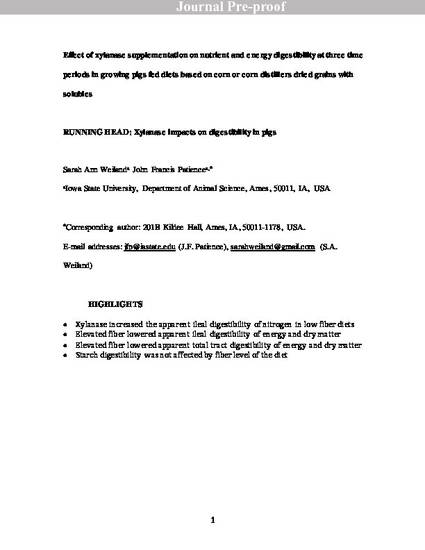
A digestibility trial was conducted to better understand how xylanase impacts diet utilization in pigs by measuring its impact on the digestibility of energy, nitrogen, fat, fiber, and starch in the small and large intestine and across the total tract at three collection periods. Thirty-two 16-week-old gilts (DNA 600 [DNA Genetics, Columbus, NE, USA] × C22 [PIC Inc., Hendersonville, TN, USA]) were surgically fitted with T-cannulae at the terminal ileum, housed individually, and assigned to 1 of 4 dietary treatments in a completely randomized design, providing 24 observations per treatment Diets were arranged in a 2 × 2 factorial:0 vs 165 mg xylanase/kg (27,225 birch xylan units (BXU)/kg) of finished feed to corn-soybean meal diets and 0 g/kg (lower fiber: LF) vs 300 g/kg (higher fiber: HF) corn distillers’ dried grains with solubles (DDGS). Prior to surgery, the body weight (BW) of the pigs averaged 37.3 ± 0.8 kg. Three collection periods consisting of a 2-day fecal collection followed by a 3-day ileal collection occurred at day 9-13, 19-23 and 39-43 when pigs averaged 46.0 ± 0.4, 54.1 ± 0.4, and 70.3 ± 0.5 kg, respectively. Ileal and fecal samples were analyzed to determine the apparent ileal digestibility (AID) and apparent total tract digestibility (ATTD) of gross energy (GE), dry matter (DM), neutral detergent fiber assayed with heat stable amylase (aNDF), acid detergent fiber (ADF), and nitrogen (N), and the AID of starch and amino acids (AA). Apparent fat digestibility values were corrected for endogenous losses and reported as true ileal digestibility (TID) and true total tract digestibility (TTTD). Xylanase inclusion tended to decrease AID of aNDF and decreased ADF in LF diets, but had no impact in HF diets, resulting in a fiber level (FL) × xylanase interaction (P ≤ 0.100). The AID of nitrogen increased with xylanase in LF diets, but decreased in HF diets, resulting in a FL × xylanase interaction (P = 0.025). Xylanase inclusion tended to increase the hindgut disappearance of aNDF and ADF (P ≤ 0.100). In LF diets, xylanase decreased ATTD of ADF, but increased ATTD of ADF in HF diets resulting in a FL × xylanase interaction (P = 0.010). Xylanase inclusion changed the pattern of hindgut disappearance and ATTD of nitrogen over the three collection periods, resulting in a xylanase × collection period interaction. Overall, xylanase supplementation slightly increased digestibility in pigs fed lower fiber diets, and had no impact on digestibility in higher fiber diets.
Available at: http://works.bepress.com/john-patience/164/

This is a manuscript of an article published as Weiland, Sarah Ann, and John Francis Patience. "Effect of xylanase supplementation on nutrient and energy digestibility at three time periods in growing pigs fed diets based on corn or corn distillers dried grains with solubles." Animal Feed Science and Technology (2021): 114929. doi:10.1016/j.anifeedsci.2021.114929. Posted with permission.